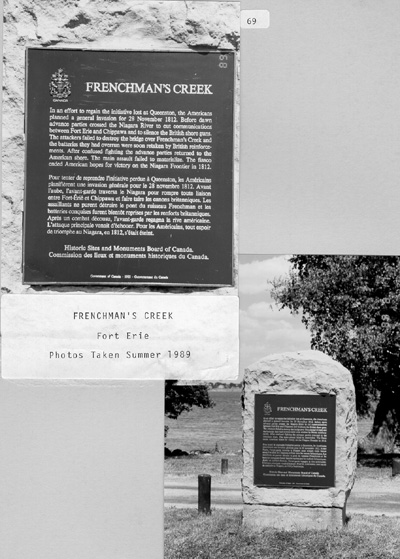Frenchman's Creek National Historic Site of Canada
Fort Erie, Ontario

View of monument
© Parks Canada/Parcs Canada, 1989.
Address :
Niagara River Parkway, Fort Erie, Ontario
Recognition Statute:
Historic Sites and Monuments Act (R.S.C., 1985, c. H-4)
Designation Date:
1921-05-21
Dates:
-
1812 to 1812
(Significant)
Event, Person, Organization:
-
War of 1812
(Event)
-
Lieutenant Colonel Charles Boerstler
(Person)
-
Lieutenant Colonel Cecil Bisshopp
(Person)
-
Lieutenant Bartley
(Person)
-
Lieutenant McIntyre
(Person)
-
49th Regiment
(Organization)
-
41st Light Infantry
(Organization)
Other Name(s):
-
Frenchman's Creek
(Designation Name)
Research Report Number:
2009-CED/SDC-004
Plaque(s)
Here was fought the action of Frenchman's Creek November 27th. 1812.
Landing place on Fenian Raiders, May 31st. 1866.
Pro Patrio
In memory of the non-commissioned officers and men of the Royal Artillery, 49th Regiment and Norfolk Militia. Killed in action at this place.
Existing plaque: mouth of Frenchman's Creek Niagara River Parkway, Fort Erie, Ontario
In an effort to regain the initiative lost at Queenston, the Americans planned a general invasion for 28 November 1812. Before dawn advance parties crossed the Niagara River to cut communications between Fort Erie and Chippawa and to silence the British shore guns. The attackers failed to destroy the bridge over Frenchman's Creek and the batteries they had overrun were soon retaken by British reinforcements. After confused fighting the advance parties returned to the American shore. The main assault failed to materialize. The fiasco ended Amerian hopes for victory on the Niagara Frontier in 1812.
Description of Historic Place
Frenchman’s Creek National Historic Site of Canada is located on a point in the centre of a bridge over Frenchman’s Creek, a tributary of the Niagara River, near Bridgeburg, Ontario. It is marked by a Historic Sites and Monuments Board of Canada plaque, located within the designated place, approximately 85 metres from the centre of the bridge. There are no known extant resources associated with the War of 1812 battle that took place in this area. Official recognition refers to a polygon centred on a point at the centre of the bridge.
Heritage Value
Frenchman’s Creek was designated a national historic site of Canada in 1921 because: the British action at Frenchman’s Creek forced American advance parties back across the Niagara River and ended American hopes for victory on the Niagara frontier in 1812.
The battle at Frenchman’s Creek, a minor skirmish, occurred early on November 28, 1812. It was part of a two-pronged American attack on Frenchman’s Creek and Fort Erie, in preparation for a general invasion of the Niagara Frontier. American Lieutenant-Colonel Charles Boerstler was directed to attack the guard at Frenchman’s Creek and destroy the bridge over the creek along the edge of the Niagara River. This was intended to stop British reinforcements at Chippawa from interfering with the main invasion at Fort Erie. Boerstler was ultimately repulsed by Lieutenant Colonel Bisshopp’s forces and was unsuccessful in his attempts to destroy the bridge. The failures at Frenchman’s Creek contributed, in part, to the cancellation of the larger American invasion planned for the Niagara Frontier at the end of 1812.
Source: Historic Sites and Monuments Board of Canada, Minutes, March 2009.
Character-Defining Elements
Key elements contributing to the heritage value of this site include: its location in the area of the mouth of Frenchman’s Creek, a tributary of the Niagara River; its proximity to Fort Erie and Fort Chippawa, both important national historic sites of Canada; the relationship of the site to its plaque, which is located on the Niagara River Parkway 80 metres southeast of the bridge; the surrounding viewscapes, including the Niagara River, Fort Erie and the largely wooded area to the southwest; the integrity of any surviving or as yet unidentified archaeological remains which may be found within the site in their original placement and extent.